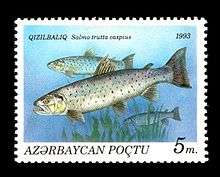Salmon problem


| Part of a series on |
| Indo-European |
|---|
 |
|
|
Origins |
|
Archaeology Pontic Steppe East-Asia Eastern Europe Northern Europe Pontic Steppe Northern/Eastern Steppe Europe
South-Asia Steppe Europe Caucasus India |
|
Peoples and societies Indo-Aryans Iranians Europe East-Asia Europe Indo-Aryan Iranian |
|
|
The term salmon problem (also known by the German term Lachsargument)[1] is used in Indo-European studies to refer to an outdated argument in favour of placing the Indo-European urheimat in the Baltic region (as opposed to the Eurasian Steppe), based on the cognate etymology of the respective words for salmon in Germanic and Balto-Slavic languages.[2] It is also known as the salmon argument.[3]
The reasoning went as follows: Since the term for Atlantic salmon in the Germanic, Baltic and Slavic languages could be derived from a common Proto-Indo-European root *laḱs,[4] the urheimat of the Indo-Europeans must be located where both these languages and the object it describes can be found: Northern-Central Europe. This argument was first put forward by German philologist Otto Schrader in 1883.[5] The argument was subject to continued scholarly debate throughout the late 19th and early 20th centuries, particularly in German academia.
In 1953, German indologist Paul Thieme submitted that the descendants of laḱs- found in the Caucasus were used to describe the trout (Salmo trutta) rather than the Atlantic salmon (Salmo salar).[6] American philologist George Sherman Lane concurred in a 1970 conference paper: "In my opinion, the name in question probably did refer originally not to the Salmo salar at all, but rather to the Salmo trutta caspius of the northwest Caucasus region."[7] This lent support to the Kurgan hypothesis.
See also
- Historical linguistics
- Comparative method (linguistics)
- Proto-Indo-European homeland
- North European hypothesis
- Kurgan hypothesis
References
- ↑ Schrader, Otto (1883). Sprachvergleichung und Urgeschichte. Linguistisch-historische Beiträge zur Erforschung des indogermanischen Altertums. [Language comparison and ancient history. Linguistic-historical contributions to the investigation of Indo-European antiquity.] (1st ed.). Jena: Costenoble.
- ↑ Diebold, A. Richard (1976). "Contributions to the Indo-European salmon problem". In Christie, William M. Current proceedings in historical linguistics. 2nd International Conference on Historical Linguistics, Tucson, 12–16 January 1976. Amsterdam: North-Holland. pp. 341–387.
- ↑ Adams, Douglas Q. (1985). "PIE *lokso-, (anadromous) brown trout' and *kokso- 'groin' and their descendants in Tocharian: A coda to the Lachsargument.". Indogermanische Forschungen. Berlin: Walter de Gruyter (90): 72–78.
- ↑ Miller, Gary D. (2007). "Indo-European and the Indo-Europeans" (PDF). University of Florida. Retrieved 11 July 2016.
- ↑ Giacalone Ramat, Anna; Ramat, Paolo (1998). The Indo-European Languages. New York: Routledge. ISBN 978-0-415-06449-1.
- ↑ Thieme, Paul (1953). "Die Heimat der indogermanischen Gemeinsprache" [The homeland of the common Indo-European language]. Abhandlungen der geistes- und sozialwissenschaftlichen Klasse. Mainz: Akademie der Wissenschaften und der Literatur, Wiesbaden (11).
- ↑ Lane, George Sherman (1970). "Tocharian. Indo-European and Non-Indo-European Relationships.". In Cardona, George; Hoenigswald, Henry M.; Senn, Alfred. Indo-European and Indo-Europeans. Third Indo-European Conference at the University of Pennsylvania. Philadelphia. p. 83.